Corona in Corona: how the deadly virus shook a neglected neighborhood
The toll the coronavirus has taken on the Queens neighborhood in NYC tells a story of race, poverty and inequality in America
by Amanda Holpuch in New York
Each morning, when Cathy Rojas logs in to teach her students in Corona, Queens, she faces a crowd of students more worried about their next meal than their US history homework.
Rojas gives lectures about century-old race riots and labor movements to teenagers who have watched their families step out to work in a pandemic when most everyone else has been told to stay home.
Their families have little choice. Covid-19 hit Corona, a district in the borough of Queens New York, hard. The first, deadly, wave is over but the economic and health consequences will likely shake the neighborhood for years to come. The toll the coronavirus has taken on the coincidentally-named Corona tells a story of race, poverty and inequality in modern America.
Rojas’s high school is 98% Latino and is meant for teenagers who have been in the US less than four years. Many of their parents or guardians are undocumented immigrants, who have either been working through the pandemic or lost their jobs without access to government relief. Several students have been sick themselves or lost a family member to Covid-19.
“What we have seen is that some students who were high flyers, who were excellent students throughout the school year, have actually stopped handing in work or have been handing in minimal work,” Rojas said.
The high school is on the border of Corona, home to the New York City zip code which has seen the highest number of deaths in the city, 392 , and the highest number of identified coronavirus cases: 4,014.
Roughly 10 miles from whiter and wealthier Manhattan neighborhoods where there were almost no deaths from the illness, Corona sits at the crux of the economic and health toll Covid-19 has had on undocumented, Latino immigrant communities across the US.
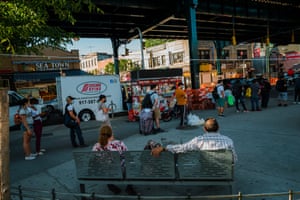
More than half the neighborhood is Latino and it has one of the highest foreign-born populations of any district in the city – 63% of its residents were born outside the US.
Nationally, Latinos are overrepresented among people who have caught the virus in 43 of the 44 states that provide information on the group, according to research by demographer Rogelio Sáenz for Latino Decisions.
In New York City, 34% of deaths were Latinos though they make up 29% of the city’s residents. Black people account for 28% of deaths but make up 22% of the city’s population; white people account for 27% of deaths but are 32% of the population and Asians account for 7% of deaths and are 14% of the city’s residents.
Corona is 36% Asian, which includes undocumented people, but there have been fewer deaths in that population citywide. One possible factor for this is that Covid-19 began in east Asia. Queens residents with ties to the region said they were able to prepare earlier because of warnings from family and friends.
Democratic representative Alexandria Ocasio-Cortez, who represents the district, said Covid-19 “poured gasoline” on the neighborhood’s existing problems. And under the most openly anti-immigrant president in modern history, government negligence have left people struggling to get food and financial aid in a pandemic which has killed more than 110,000 Americans.
Community groups are filling in the gaps as best they can on tight budgets.
And teachers like Rojas have seen their jobs shift to also include linking students and their families with food and rent assistance, while exploring the minutiae of government policy. On calls about grades, Rojas asks parents if they know how to access healthcare depending on their immigration status. “Because that’s what my students need more than a history lesson,” she said.
The center of the city’s Covid-19 crisis
The daughter of Colombian immigrants, Rojas was raised in Queens. The 28-year-old is housing relatives who rented rooms in apartments with people who had Covid-19. “For all of April, every day I was saying rest in peace to somebody,” she said.
Corona is often grouped together with Elmhurst, its demographically similar neighbor to its west. The main hospital for both areas is Elmhurst hospital – which saw an “apocalyptic” surge in coronavirus patients in March.
On a hazy, hot weekday in early June, the streets winding through the neighborhood were filled with small groups of runners and multi-generation families walking dogs and pushing strollers along the neighborhood’s grand, green tree-lined streets. The constant sound of sirens in the preceding months had finally been exchanged for a soundtrack of chirping birds.

But coronavirus still casts its shadow over the neighborhood. For more than a half mile along 57th Avenue people lined up for Covid-19 testing, some had brought out chairs and sun umbrellas to endure the long wait. Similar lines are evident at food donation centers in the neighborhood, with one stretching more than 20 blocks.
The economic crisis from Covid-19 has put hunger centre stage for residents, whose homes are also some of the most crowded in the city.
Social epidemiologist Sandra Albrecht studies socio-cultural and environmental factors that affect the health of immigrants, particularly Latinos, in the US. She said Corona was an obvious candidate for the spread of the respiratory illness because of the crowding and issues such as limited access to health insurance. In Corona, 25% of people don’t have health insurance, while the average across the city is 12%.
When New York closed down, it was essential workers from neighborhoods such as Corona who kept things running. “Family members may have remained at home this entire time, but if they have even just one person in the household that needs to work, that one person can bring back the virus,” Albrecht said.
Another worrying factor for the long-term is that Corona has the most cases of uncontrolled diabetes in the city and people with diabetes have higher rates of serious complications and death from Covid-19.
“The fact of that matter is the neighborhood, especially of Corona, is quite limited in terms of the resources,” Albrecht said. “Whether or not it looks bad now, the point is because of the limited resources in these neighborhoods, they are going to be experiencing a disproportionate number of deaths from here on and forward in the future, especially if there are no resources deployed to these neighborhoods to help minimize the impact of Covid.”
Albrecht, an assistant professor at the Columbia Mailman School of Public Health, said the early Covid-19 narrative was that it is “an equal opportunity virus and will impact all populations”. She said resources did not seem to be deployed with the special conditions in low-income or immigrant communities in mind.
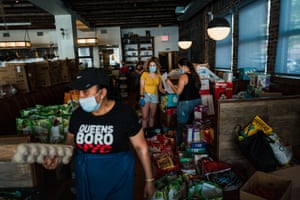
Scrambling to get food and funeral arrangements
César has lived undocumented in the US since 1996 and learned a long time ago how to operate without the state’s support. The Guardian is withholding his last name because of his immigration status.
César said what his community needs most is clear communication and leadership from the government. Without it, he, his close friends and family have created their own support network.
In weekly phone calls, or socially-distanced in-person conversations, he checks in to see what people need, then figures out how to get it.
“Some places they have food, so what I do, is I share it in our community,” César said. “I call them, ‘what are you doing, what do you need?’ We try to help everyone.”
Covid-19 has impacted each facet of his life, he said. The 42-year-old hasn’t worked since 15 March, when the restaurant he worked at closed. His wife also lost her job and they have been draining their savings to help support their two daughters. “We have no money to pay the bills,” he said.
César said his inability to pay rent hasn’t been a problem yet because the building owner has been understanding.
Legally, the owner doesn’t have a choice – New York City has a rent moratorium. But even before the pandemic, some landlords used tenants’ undocumented status to threaten them.
Despite the myriad challenges, César was optimistic.
“No matter what happened before or now, it is never too late to start again,” César said. “You gotta do what you gotta do.”
Diana Moreno, worker rights director at the not-for-profit New Immigrant Community Empowerment (Nice), said many of their members were anxious to return to work, in part because of the international flow of people’s paychecks.
The World Bank projected global remittances would decline by about 20% this year, the sharpest decline in recent history. “The impact on our community is international, really,” she said.
Before the pandemic, Nice was focused on fighting worker exploitation and the lack of access to things such as affordable housing for members primarily in Corona, Elmhurst and Jackson Heights.
Now, it and other community groups have been thrust into the role of disaster relief agency. Volunteers described how they have scrambled to get food to hungry families and to navigate funeral arrangements for people born outside the US.
“I didn’t think we would have to be in contact with the Mexican consulate to talk about repatriation of people’s remains,” Moreno said. “That is something that is now part of our jobs. ”
Moreno said the disaster-relief work she’s been doing eroded the progressive, immigrant-friendly reputation of New York City. “That has really for me, and I think a lot of people, lifted the veil of how the longstanding inequity is absolutely hitting our communities regardless of the particular reputation of a city or state,” Moreno said.
That longstanding inequity is why the community group Centro Corona describes its current aid relief operations as a political movement, not charity. “It is building with people and letting them know their needs are valuable,” said Mauricio Piratova, a Centro Corona volunteer.
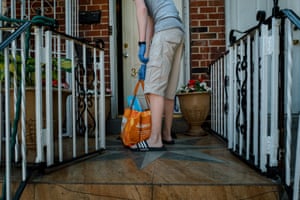
Early on, Piratova said they realized an on-call doctor would be needed because so many people they work with don’t have health insurance. They’ve introduced activities like weekly, virtual movie nights for children and have moved their homework help programs to phone or video chat. They provide direct cash assistance for people facing eviction. And like at Nice, they are helping people transport remains from one country to another.
“The city abandoned people of color and immigrant communities,” said Piratova. “And it shouldn’t be that non-profit organizations, little organizations with no funds, have to start doing things. It shouldn’t be the reality we are living. What we need is basically essentials, we need food available for everyone. If you’re telling people they can’t go out, they can’t go to work, just give them food.”
Even with these efforts to help, people are slipping through the cracks.
Invisible need in an invisible crisis
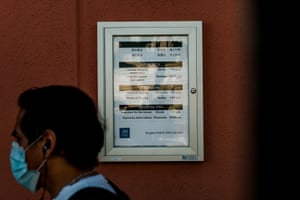
Hundreds of indigenous and minority languages are spoken in Corona and an analysis by the Endangered Language Alliance found the city’s most multilingual communities have been most affected by the virus.
Corona is one of the most linguistically diverse parts of the city – in part because a wave of migration from Mexico, Guatemala, Ecuador and Peru to New York City in the 1990s included a substantial Indigenous population.
A study ELA published with the city health department in 2019 found that while indigenous Latin American communities were substantial and growing, they “often remain dispersed, invisible, and without access to services”.
Don, a 51-year-old undocumented immigrant, like César is from an indigenous community in Pueblo, Mexico, and speaks Spanish as well as Nahuatl, which was spoken by the Aztecs.
He said he’d heard about food assistance programs but the demand was so high that his family was not expecting any help soon.
He has lived in Corona for about eight years and shares an apartment there with his three brothers and four young nieces and nephews. With each adult in the family’s hours cut or work shut down all together, the family is struggling to get food. “It is difficult because we can’t tell our kids if we are not going to eat or if we are going to eat,” Don said, through a translator.
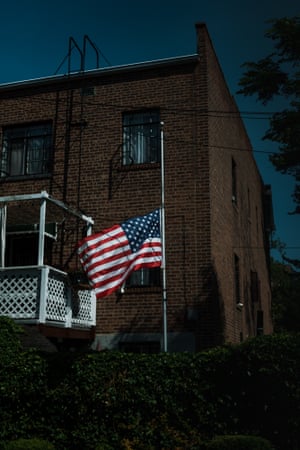
Though he’s worried about getting sick, all he wants is more work.
“Rent is not going to wait for us,” Don said. “That’s what’s more worrying for us.”
Cuomo said in early May that there would be no additional Covid-19 assistance for undocumented immigrants without federal funding after California established its own $125m fund to aid undocumented people in the state.
New York state’s department of health said it had opened two testing sites in Corona and other low-income, minority neighborhoods hard hit by the virus. It has also given $25m to food pantries and provides services at no cost in multiple languages.
The pandemic has not halted the Trump administration’s attack on immigrant communities.
Undocumented people don’t qualify for unemployment aid or the federal stimulus checks and because of their status, their US citizen spouses are also denied the assistance. It took a month for authorities to clarify that immigrants seeking permanent residence wouldn’t be penalized if they sought treatment and testing for Covid-19. The government has ignored public health warnings to take people out of immigration detention, where they are held on civil immigration violations, not criminal charges. The spread of coronavirus in Guatemala has been directly tied to US deportation flights.
This oppression isn’t lost on the students in Rojas’s US history class, who ended the school year learning about the Civil Rights movement of the 1960s.
Rojas said one standout essay this semester drew parallels between the century-old Triangle Shirtwaist Factory fire – which claimed the lives of 146 workers, mostly young women who had recently immigrated from Eastern Europe – and the lack of PPE made available to essential workers. Another student connected race riots which followed the first world war to the New York Police Department’s over-policing of communities of color to enforce social distancing guidelines.
Students managed this work from crowded apartments and while caring for younger brothers, sisters and cousins. Some had only just got internet access at the end of May. Rojas hopes in-person classes return in the fall, so she knows students have access to two meals per day and a safe learning environment.
Rojas said: “Even as a historian, I did not expect this amount of neglect”



